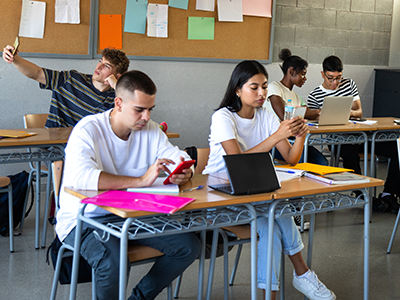Managing the Use of ChatGPT and Cell Phones in Schools
Watch the RecordingListen to the Podcast
To what extent are mobile devices and artificial intelligence (AI) being used in the classroom and what are the emerging best practices for managing their use?
Kevin Baird, Chairman of the Global Center for College and Career Readiness, and Ruth Brus, National Faculty at the Center and Vice President of Learning Services at Meteor Education, explored these questions in the edLeader Panel “Best Leadership Practices: Managing Devices and Technology for Distraction-Free Learning.”
Baird posed three questions for the use of AI, specifically ChatGPT, and cell phones in the classroom:
- How is it being used?
- What is the nature of the experience (real-world relevance)?
- Is it a positive social experience?
The conversation, as well as a survey completed by the attendees, will help inform a national study the Center is conducting on best leadership practices for managing devices and technology in K-12.
AI (ChatGPT)
Teachers are just beginning to explore AI in the classroom, particularly ChatGPT, said Brus. “It’s out there and it’s going to be a part of our education system, so how can we embrace it in a way that is meaningful for our students?”
ChatGPT is for text generation; it is not designed to gather facts nor is it a search tool. “This is a critical element to understand as we’re thinking about how we expose students, teachers, and administrators to these tools because ChatGPT is not meant to find facts,” Baird explained.
ChatGPT can generate inaccurate information as if it were fact, called an “AI hallucination.” AI hallucinations create a lack of trust and waste time, which are both distractions in learning.
A best practice in the use of ChatGPT is using the content it creates to process—critique, analyze, and/or edit—the information it creates. It can also be used to initiate conversation about an opinion it provides. “These are all emerging best practices because, just like mobile phones in the school, we haven’t written the book on exactly what to do,” Baird said.
Using AI as an assessment tool is not recommended because its accuracy can be questionable. Baird cautions teachers, “If AI is writing your exam, it’s probably not the best exam, and if AI can answer your exam, it’s really not the best exam.”
Keeping in mind that AI does not necessarily provide facts or think independently is important when considering real-world skills (e.g., college and career readiness). AI may be more useful in some careers, such as software engineering code review and customer operations, than in others, like human resources or risk and compliance.
AI is best used to initiate dialogue, helping humans to think more broadly, deeply, and quickly. “If my viewpoint of whatever [AI] says is that it is just one view…let’s analyze it. That’s a best practice,” said Baird.
Mobile Devices (Cell Phones)
“We know quite a bit about the impact of mobile device usage on students,” Baird said, pointing to a survey of about 1,000 teachers in which close to 41% said they found cell phone use in the classroom to be “incredibly distracting.”
Some reasons teachers said cell phones are a distractor when used for instruction are:
- There are inadequate lesson plans
- The teacher has to monitor if the phone is being misused
- Students don’t have the same devices so interactive test-taking is difficult
When students use cell phones inappropriately, they can be a dangerous tool, causing harm to themselves and others in the form of bullying and even human trafficking. Chronic cell phone users have more physical ailments and mental health issues, according to a National Institutes of Health survey, and the Surgeon General also has warned that social media might harm children and adolescents.
“This is actually why I partnered with Yondr to figure out what’s really best practice here,” Baird said. “The first thing we have to do is do no harm. If we place a cell phone in a classroom, or even if we allow it inside of the school, there could be harm happening.”
While research suggests that cell phones lack equity and impact as a content-delivery or content-interaction experience, banning them is a challenge. “I want us to think about, if we’re going to use them, why and how do we use them,” said Baird. “What is the big why? What’s the strategy for having it in the school?”
“Distractions are really harming our students, their mental health, their physical health,” he added. “I have become absolutely convinced…that distraction and managing it and teaching ourselves to manage it is critical for the future.”
Learn more about this edWeb broadcast, Best Leadership Practices: Managing Devices and Technology for Distraction-Free Learning, sponsored by Meteor Education.
Watch the RecordingListen to the Podcast
Join the Community
Leadership and Innovation is a free professional learning community that serves as an online forum for collaboration on leadership and innovation in schools to meet the needs of the next generation.
We empower teachers and education leaders in creating ProSocial Learning Experiences so their students emerge inspired, compassionate, and future ready.
Article by Diana St. Lifer, based on this edLeader Panel





Comments are closed.